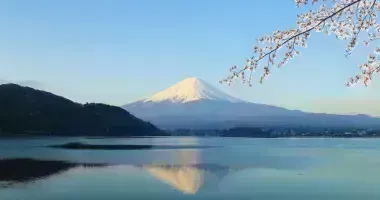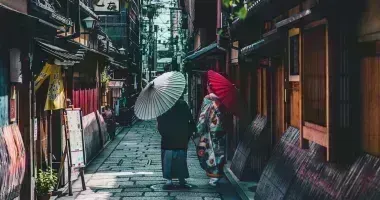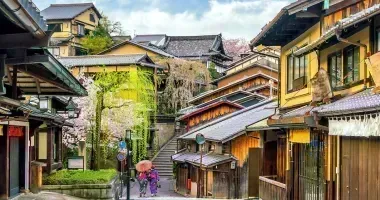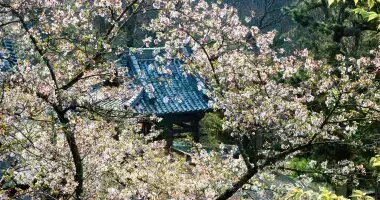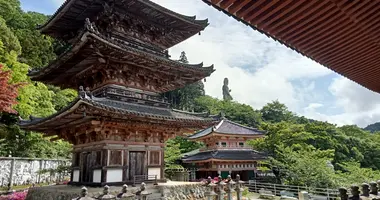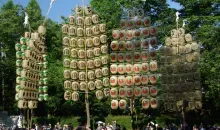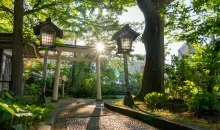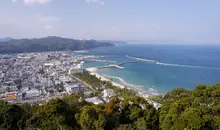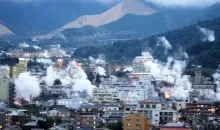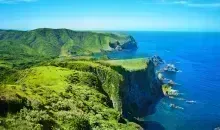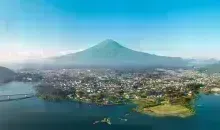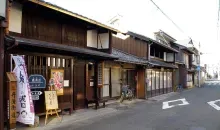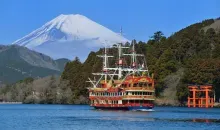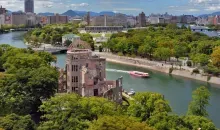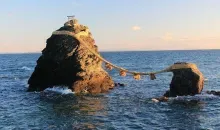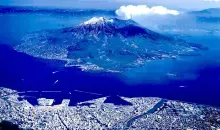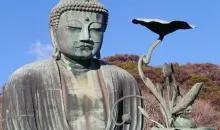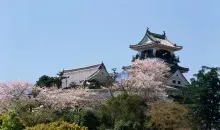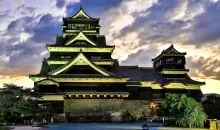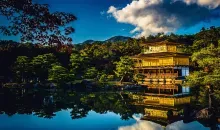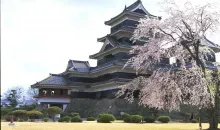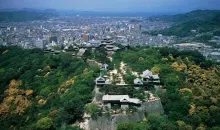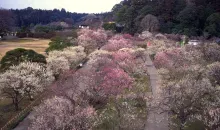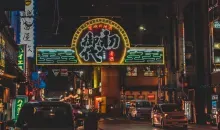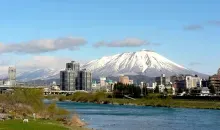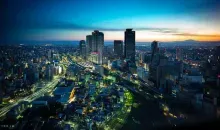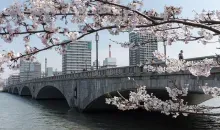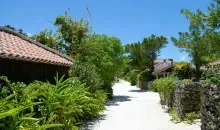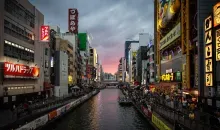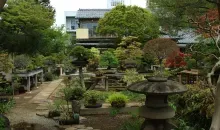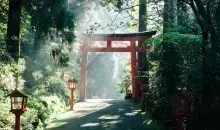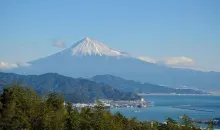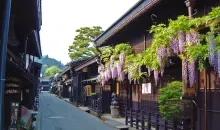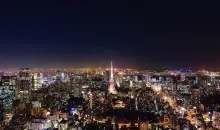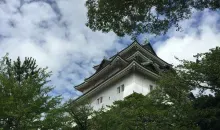Kumano 熊野 紀伊半島
- Published on : 01/12/2021
- by : G.L.
- Youtube
Local Time 05:21
Symbol : sunny
Temp : 24.5°C
Date : Today
Symbol : cloudy
Temp : 25.9°C
Date : Tomorrow
Symbol : cloudy_rainy
Temp : 24.6°C
Date : Friday
Symbol : cloudy
Temp : 23°C
Date : Saturday
Local Time 05:21
Symbol : sunny
Temp : 24.5°C
Date : Today
Symbol : cloudy
Temp : 25.9°C
Date : Tomorrow
Symbol : cloudy_rainy
Temp : 24.6°C
Date : Friday
Symbol : cloudy
Temp : 23°C
Date : Saturday
Take a look at our travel tips for Kumano and its surroundings
In the south of Kansai, the mountainous Kii peninsula has been visited by pilgrims since the 12th century. A sacred and UNESCO-listed region offers great hiking and hot springs.
Kumano is a charming coastal town in Mie Prefecture. For a small town of about 17,000 people, there is a lot to see and do in Kumano itself and in the surrounding hills. Kumano has some historic streets that are pleasant to stroll down, which include some traditional public baths (sento) and some shrines and temples including Kinomoto Shrine and Shohoji Temple.
It is located on the Iseji Road of the famous Kumano Kodo Sacred Pilgrimage Route, which runs from Ise-Jingu Shrine to the three major Kumano shrines in nearby Wakayama Prefecture: Kumano Hayatama Taisha in Shingu, Kumano Nachi Taisha in Nachi, and Kumano Hongu Taisha in Hongu.
The Kumano Kodo was listed as a UNESCO World Heritage Site in 2004, under the name "Sacred Sites and Pilgrimage Routes in the Kii Mountain Range".
This is a sacred area, a region of myths and legends, where for over 1500 years pilgrims have been walking along forest paths and climbing peaks. The particularity of the Kii Mountains is that they embody Japanese syncretism, the marriage of the two main religions of the country: Shinto, being the first, and Buddhism which arrived from China via Korea in the sixth century.
- Read also: The Kii peninsula
What to do and see in Kumano?
The Matsumoto-toge pass
Many visitors come to Kumano to cross the Matsumoto-toge pass, a fairly easy climb on the Iseji pilgrimage route.
The hike takes about 2 hours to cover 5 km. The walk passes through bamboo forests, up and down stone steps dating from the Edo period, and through a forest to reach the summit at 135m. At the top is a stone statue of Jizo, bearing the scars of an encounter with a hunter, who is said to have mistaken the statue for a goblin.
The Oniga-jo rock formation
If you wish to extend your walk, head south to Oniga-jo, past the ruins of the relics of the Muromachi period (1336 - 1573) Oniga-jo Castle. A narrow path leads around the peninsula and offers superb close-up views of the tufa cliffs of Onigajo Rocks, the "Devil's Castle", a UNESCO World Heritage Site.
The spectacular amber-colored rock face stretches 1.2 km around a small point offering not only superb views of the rocks and the sea.
Shichiri-mihama beach
Shichiri-mihama beach, visible from the rocks of Onigajo, is the longest pebble beach in Japan. The name "shichi-ri" refers to the ancient Chinese-Japanese distance called "ri", which equals about 3.93 km. "Shichi", meaning the number 7, seven ri would be approximately 27.5 km. The beach is actually closer to 22 km long and is a beautiful natural phenomenon.
Shichiri-mihama beach is part of Yoshino-Kumano National Park and is known as a breeding ground for loggerhead turtles between May and September each year. The beach also hosts the annual Kumano fireworks display, which takes place on 17 August and is one of the largest and most spectacular in the country.
Shishiiwa
Shishiiwa, "Lion Rock", is located on Shichiri-mihama beach, south of central Kumano-shi. Shishiiwa is a 25-metre-high rock in the shape of a lion, which has been formed over thousands of years by the force of nature.
From mid-May onwards, for about a month, the sun can be seen in the lion's "jaws" and in November and December the moon is in a similar position.
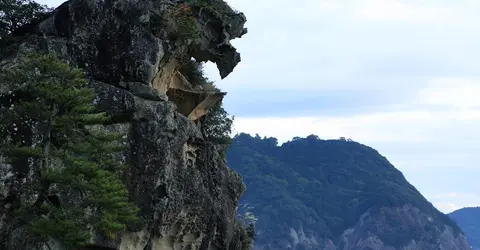
The Shishiiwa, the rock in the shape of a lion roaring towards the sea
しらたきあおい さん
Hana-no-Iwaya Shrine
Hana-no-Iwaya Shrine is one of the oldest shrines in Japan, although there are dozens of "oldest shrines in Japan". It is located at the foot of a 45m high and 80m wide cliff. Hana-no-Iwaya is said to be the place where the mother of all gods, Izanami Mikoto, who gave birth to Kagutsuchi Mikoto, the god of fire, was buried after being burned to death in childbirth.
The cliff face of the shrine is dotted with small holes caused by erosion and it is considered appropriate to place a white stone in one of the holes while making a wish. Prayers for health, peace, and happiness are often written on the stones. For countless generations, visitors have left such messages. Recent prayers for safe driving and successful university entrance exams can be seen, as well as expressions of hope for health and happiness.
Traditional religious ceremonies dating back thousands of years are still performed at the Hana-no-Iwaya Shrine every year on February 2 and October 2 during the Otsunakake Shinji (string change ritual). Shinto priests dance in homage to the gods and a giant 170-meter-long rope is lowered from the cliff top and tied to a sacred pine tree.
Ubuta Shrine
Ubuta Shrine, like Hana-no-Iwaya Shrine, is linked to the local version of the myth of Izanami Mikoto. According to Japanese mythology, Izanami Mikoto and her husband Izanagi Mikoto were the creators of the earth on earth (the islands of Japan) through their offspring.
The Ubuta Shrine is therefore associated with a safe childbirth. The main hall of the shrine is surrounded by stones from the nearby beach of Shichiri-mihama. Another belief is that expectant mothers can predict the sex of their unborn child by closing their eyes and reaching behind them to pick up a stone. A round stone indicates a girl, a longer stone a boy. If the prediction comes true and the birth is successful, the mother returns a stone to the Shichiri-mihama beach shrine.
The surroundings of Kumano, between mountains and beaches
This syncretism has given rise to the three great sanctuaries of the region, the Kumano Sanzan ("The Three Summits of Kumano": Hongu, Hayatama, and Nachi), and to famous pilgrimage paths, five trails that link the Kumano sanctuaries to the sacred mountain of Shingon Buddhism, Mount Kôya. The entire area was declared a UNESCO World Heritage Site in 2004.
The west coast of the Kii Peninsula, open to the southeast of Shikoku, seems more reserved for tourists than pilgrims, who travel by train from Osaka to Tanabe. This pretty seaside resort, which acts as a gateway to the sacred peaks, offers the best tourist office in the region, is very well informed, multilingual (English and some French), and involving the locals in the development of local tourism. Trains and buses then take you south to Shirahama, famous for its long white sandy beach, and for the Saki no Yu, reputed to be one of the oldest hot spring settlements in the country.
A network of local buses connects Tanabe and Shirahama to the sites on the east coast, including the three must-see shrines. The Kumano Nachi Taisha is accessible from the town of Kii-Katsuura, a syncretic place of worship perched in the mountains, sometimes lost in the mist, which is home to the Buddhist temple of Seiganto-ji, the Shinto shrine of Nachi, and the waterfall of the same name (Nachi no Taki).
Heading north, the Kumano Hayatama Taisha site has been located just a stone's throw from downtown Shingu and the banks of the Kumano-gawa since the 12th century. Don't miss its museum, a repository of pilgrimage artifacts.
You will have to go deep into the cedar forests, climb the cobbled paths of Kumano, or take a 1 to 2-hour bus ride (from Tanabe, Shirahama, or Shingu) to reach the Kumano Hongu Taisha, located at the heart of the pilgrimage path network, a short distance from Mount Kôya. In this sanctuary, the most prestigious of the three, the faithful honor the spirit of Amaterasu, goddess of light.
Finally, pilgrims can relax in the many onsen in the region: Kawayu, where you can bathe in the bed of the Oto River; Yunomine, a hot spring several hundred years old; or Totsukawa and Ryûjin.
How do I get to Kumano?
JR Kumano-shi Station is the main access point, either by train or bus.
- From Nagoya
The first express train to Kumano Station from Nagoya Station is the 8:05 am Wide View Nanki, which arrives in Kumano at 11:13 am Regular highway buses (which are cheaper than the train) from Meitetsu Bus Station at Nagoya Meitetsu Station go to Shingu via Kumano.
Return buses to Nagoya leave from behind the tourist information center in front of Kumano-shi Station. Other buses from Kumano Station go to Shingu (50 minutes) and to Seiryu-so Onsen near the beautiful Kitayama River (also about 50 minutes).
- From Osaka
Arriving by Kuroshio Limited Express from Tennoji Station in Osaka, visitors should change at Kii-Katsuura Station, aka Nachi-Katsuura, or at Shingu. The journey takes about 5 hours and the fare will be covered by the Japan Rail Pass. It is slightly faster to take the Kintetsu Rail at Osaka or Tsuruhashi station to Tsu, then change to a JR Limited Express Nanki at Kumano-shi.
Interested by Kumano
Discover other cities to explore











